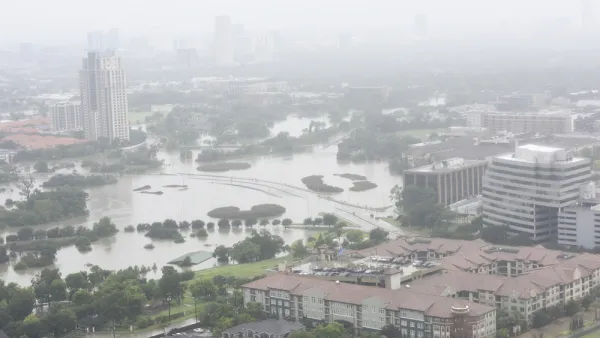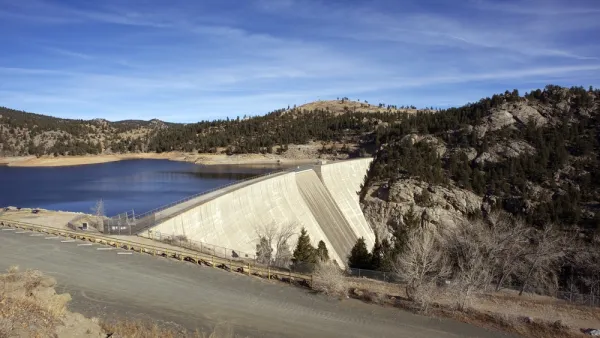I first learned of Okham’s Razor in an undergraduate economics class. Also called the Law of Parsimony, the idea states that the simplest of two competing ideas or theories is preferable to the more complicated one.
I first learned of Okham's Razor in an undergraduate economics class. Also called the Law of Parsimony, the idea states that the simplest of two competing ideas or theories is preferable to the more complicated one.
I was reminded of this principle while reading an otherwise excellent paper on water use and the urban heat island effect in the summer 2007 issue of the Journal of the American Planning Association. Researchers Subhrajit Guhathakurta and Patricia Gober asked an important question: does an urbanized area increase heat, which then puts increased demand on water consumption? The answer is a convincing "yes", at least in their test case of the desert city of Phoenix. Overall, a 1 degree (F) increase in the mean low temperature increased water consumption by 1.7 percent (290 gallons per month). Other variables were also important. Residential areas with larger lots and higher incomes, for example, tended to have higher water consumption. So did the presence and size of pools (although the effect was much smaller).
While these results are important in and of themselves, what caught my eye was their conclusion: Planning research and practice should address ways to combat waste heat in dense urban areas and consider the feedbacks between climate, water use, and the built environment. The strategies for mitigating heat island effects have been known for many years, but are little used, since air is a common resource, subject to "the tragedy of the commons" (Hardin, 1968). If heat were a regulated pollutant, as advised by some scholars, including Stone (2004), it would be within the jurisdiction of air quality management districts. [emphasis added] As we have shown, this would help conserve water, which is extremely important in arid regions such as the Phoenix metropolitan area.
Do we really need to start regulating "heat" like a pollutant? Is this really the most efficient and effective way to conserve water? I don't think so, and this is where the Okham's Razor comes in.
Irrespective of the problems inherent in determining what "waste heat" is, heat is not a "pollutant", at least in the sense that heat has an inherently negative impact on the quality of the environment. To the extent heat is a byproduct of human action, and is not fully accounted for in our transactions, it is an externality-an unanticipated or unaccounted for side effect, or spillover effect. But, it is not a pollutant. It is an unintended side effect of human activity.
More importantly, the policy goal is to more effectively regulate the use of water. Broadening the definition of pollution to include heat is, at best, an indirect strategy for regulating water use. It also runs the danger of creating yet another layer of bureaucracy within agencies that already struggle with enforcing cumbersome laws and regulations.
The real issue is regulating water use that reflects its scarcity. Other policy instruments are far more direct and less cumbersome. A more parsimonious way to address how we regulate water use is to apply market-based pricing. Rather than charge a flat fee, the rate should change with the level of demand. All we need to do is monitor water use and set rate schedules that reflect higher use rates. This can be done through block pricing, but we have the technology to price this is real time (evening sending a signal to the user about the current unit price).
Allowing the price to increase as demand goes up means consumers have more accurate signals about the true costs of using the resource and promotes conservation through the automatic and self-reinforcing feedback loops of market pricing. Pricing also encourages the adoption of alternative, more less water intensive uses (e.g., desert landscaping) as consumers seek ways to achieve the same quality of life goals through other means.

Analysis: Cybertruck Fatality Rate Far Exceeds That of Ford Pinto
The Tesla Cybertruck was recalled seven times last year.

National Parks Layoffs Will Cause Communities to Lose Billions
Thousands of essential park workers were laid off this week, just before the busy spring break season.

Retro-silient?: America’s First “Eco-burb,” The Woodlands Turns 50
A master-planned community north of Houston offers lessons on green infrastructure and resilient design, but falls short of its founder’s lofty affordability and walkability goals.

Test News Post 1
This is a summary

Analysis: Cybertruck Fatality Rate Far Exceeds That of Ford Pinto
The Tesla Cybertruck was recalled seven times last year.

Test News Headline 46
Test for the image on the front page.
Urban Design for Planners 1: Software Tools
This six-course series explores essential urban design concepts using open source software and equips planners with the tools they need to participate fully in the urban design process.
Planning for Universal Design
Learn the tools for implementing Universal Design in planning regulations.
EMC Planning Group, Inc.
Planetizen
Planetizen
Mpact (formerly Rail~Volution)
Great Falls Development Authority, Inc.
HUDs Office of Policy Development and Research
NYU Wagner Graduate School of Public Service





























